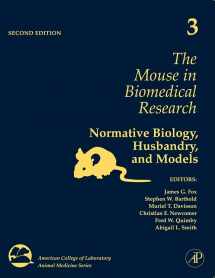
The Mouse in Biomedical Research: Normative Biology, Husbandry, and Models (Volume 3) (American College of Laboratory Animal Medicine, Volume 3)
ISBN-13:
9780123694577
ISBN-10:
0123694574
Edition:
2
Author:
James G. Fox, Stephen Barthold, Muriel Davisson, Christian E. Newcomer, Fred W. Quimby, Abigail Smith
Publication date:
2006
Publisher:
Academic Press
Format:
Hardcover
816 pages
Category:
Engineering
FREE US shipping
Book details
ISBN-13:
9780123694577
ISBN-10:
0123694574
Edition:
2
Author:
James G. Fox, Stephen Barthold, Muriel Davisson, Christian E. Newcomer, Fred W. Quimby, Abigail Smith
Publication date:
2006
Publisher:
Academic Press
Format:
Hardcover
816 pages
Category:
Engineering
Summary
The Mouse in Biomedical Research: Normative Biology, Husbandry, and Models (Volume 3) (American College of Laboratory Animal Medicine, Volume 3) (ISBN-13: 9780123694577 and ISBN-10: 0123694574), written by authors
James G. Fox, Stephen Barthold, Muriel Davisson, Christian E. Newcomer, Fred W. Quimby, Abigail Smith, was published by Academic Press in 2006.
With an overall rating of 3.6 stars, it's a notable title among other
Engineering
books. You can easily purchase or rent The Mouse in Biomedical Research: Normative Biology, Husbandry, and Models (Volume 3) (American College of Laboratory Animal Medicine, Volume 3) (Hardcover) from BooksRun,
along with many other new and used
Engineering
books
and textbooks.
And, if you're looking to sell your copy, our current buyback offer is $0.3.
Description
Normative Biology, Husbandry, and Models, the third volume in the four volume set, The Mouse in Biomedical Research, encompasses 23 chapters whose contents provide a broad overview on the laboratory mouse’s normative biology, husbandry, and its use as a model in biomedical research. This consists of chapters on behavior, physiology, reproductive physiology, anatomy, endocrinology, hematology, and clinical chemistry. Other chapters cover management, as well as nutrition, gnotobiotics and disease surveillance. There are also individual chapters describing the mouse as a model for the study of aging, eye research, neurodegenerative diseases, convulsive disorders, diabetes, and cardiovascular and skin diseases. Chapters on imaging techniques and the use of the mouse in assays of biological products are also included.


We would LOVE it if you could help us and other readers by reviewing the book
Book review

Congratulations! We have received your book review.
{user}
{createdAt}
by {truncated_author}


